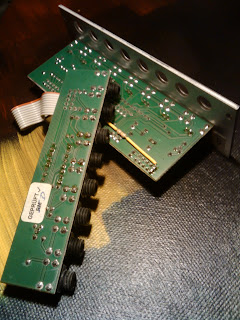Beside for safety uses, as mentioned in
one of my earlier posts, the blind-panels that Doepfer sells are also perfectly usable for all types of DIY-projects.
The 'standard' panels of 4,8,42 and 84 HP can be used for all types of original self-made modules or expanders. Sadly they don't have other sizes, but wouldn't it be nice if they had a 16HP and perhaps a 24HP to 'fill in the gaps'.
Drilling the metal plates is quite easy ( if you use the right tools ), and the panels come with pre-drilled mounting-holes.
If you don't like drilling, you can also order some pre-manufactured panels from the
Doepfer A-100 specials list;

They still have many punched A-100 standard front panels of 4HP width, punched for 8 sockets, identical to A-180 front panel but without printing, very useful for DIY or A-101-9 expansion applications. You can save yourself some money by making your own A-180 multiple for almost half the price. (sockets can also be ordered at Doepfer )
Punched A-100 standard front panels of 8HP width are still available too. Punched for 5 potentiometers and 5 sockets (same as A-102, A-103, A-105, A-120, A-122, A-123, A-124, A-130, A-131, A-138), without silk screen printing.
They even fit the
Synovatron DIY1 and DIY2 kits. (*confirmed / ,but
see feedback for remarks and more info)
Update March 3 2011:
Synovatron now sells his own generic front panels for his DIY kits.
Doepfer also still has a few 14 HP front panels punched for 2 wheels and 4 sockets ( like A-174-2 ), without printing, that might useful e.g. for a DIY wheel module. Order it with two modulation wheels and you even get the front-plate for free...
 To reach the soldering-points of the 2 LEDs i had to remove one of the modules boards on the backside.
To reach the soldering-points of the 2 LEDs i had to remove one of the modules boards on the backside.










